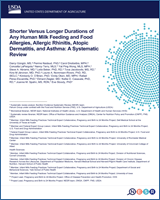
Shorter Versus Longer Durations of Any Human Milk Feeding and Food Allergies, Allergic Rhinitis, Atopic Dermatitis, and Asthma: A Systematic Review [Internet].
Güngör D, Nadaud P, Dreibelbis C, et al.
Alexandria (VA): USDA Nutrition Evidence Systematic Review; 2019 Apr.
Copyright Notice
The contents of this document may be used and reprinted without permission. Endorsements by NESR, NGAD, CNPP, FNS, or USDA of derivative products developed from this work may not be stated or implied.
NCBI Bookshelf. A service of the National Library of Medicine, National Institutes of Health.
